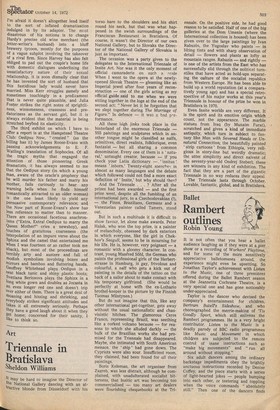Art
Triennale in Bratislava
Sheldon Williams
It may be hard to imagine the Director of the National Gallery dancing with an attractive blonde from Dtisseldorf with his torso bare to the shoulders and his shirt round his neck, but that was what happened in the swish surroundings of the Franciscan Restaurant in Bratislava. Of course, it wasn't the Director of our own National Gallery, but to Slovaks the Director of the National Gallery of Slovakia is just as important.
The occasion was a party given to the delegates to the International Triennale of Insite Art. Nor was it the only moment of official camaraderie on such a rcale When I went to the opera at the newlyopened Slovak Theatre — gleaming like an Imperial jewel after four years of reconstruction — one of the girls acting as my official guide said to me when we were sitting together in the loge at the end of the second act: "Never let it be forgotten that we slept together during The Marriage of Figaro." In defence — it was a bad p^rformance.
All these high jinks took place in the hinterland of the enormous Triennale — 555 paintings and sculptures which in another tongue might be classified as naffs, primitives, direct realists, folklorique, even fantasist — but all sharing a common denominator. Every one of them is a 'natural,' untaught creator, because — if you check your Latin dictionary — ' insitus ' means 'inborn.' Twenty-eight sneeche-, in almost as many languages and the debate which followed could not find a more exact definition of 'Insite,' but why should they?
And the Triennale . . . ? After all the prizes had been awarded — and the first prize went, despite all the fumbling of an international jury, to a Czechoslovakian (!), — the Finns, Brazilians, Germans and a Venezuelan painter called Tamers, stand out.
But in such a multitude it is difficult to show favour, let alone make awards. Peter Halak, who won the top prize, is a painter of melancholy, obsessed by dark exteriors in which everyone, like the girl in Chekhov's Seagull, seems to be in mourning for his life. He is, however, very poignant — a romantic with a gloomy character. In contrast, young Manfred SOhl, the German who paints the professional girls of the Herbertstrasse in Hamburg, is gay, frivolous and colourful, a naïf who gets a kick out of painting in the details of the tattoo on the back of a sailor about to make contact with his temporary girlfriend. (She would be perfectly at home wifh the ex-Lothario brothel-keeper in the picture by the Finnish Tuomas Mantynen.) But do not imagine that this, like any other international get-together, gets away without the usual nationalistic and chau vinistic hitches. The glamorous Ceres Franco, representing Brazil, was seething like a corked volcano because — for rea sons to which she alluded darkly — the bulk of the Brazilian works she had pro mised for the Triennale had disappeared.
Maybe, she intimated with South American menace, the ' ship ' had gone down. The Cypriots were also sour. Insufficient room, they claimed, had been found for all their paintings.
Boris Keleman, the art organiser from Zagreb, was less distrait, although he com plained, with unadulterated socialist bitterness, that Insitic art was becoming too commercialised — too many art dealers were flourishing chequebooks at the Tr ennale. On the positive side, he had good reason to be satisfied. Half of one of the big galleries at the Dom Umenie (where the International collection is housed) has been given over to the large paintings by Ivan Rabuzin, the Yugoslav who paints — in lilting tints and with sharp observation of detail — flowers and plants as lofty as mountain ranges. Rabuzin — and rightly — is one of the artists from the East who has successfully slid through the nolitical turnstiles that have acted as hold-ups separating the culture of the socialist republics from Western Europe. He has been able to build up a world reputation (at a comparatively young age) and has a special retrospective of his major works at this year's Triennale in honour of the prize he won in Bratislava in 1970.
Even Insite worlds are very different. It is the spirit and its emotive origin which count, not the appearance. The marble statues from Iraq (by Munaim Furat), scratched and given a kind of immediate antiquity, which turn in subject to fantasy like Man with Severed Heads or Unnatural Connection; the beautifully painted 'strip cartoons' from Ethiopia, very religious in story-line but weirdly dramatic; the utter simplicity and direct naivete of the seventy-year-old Ondrej Steberl; these are winners in any kind of exhibition. The fact that they are a part of the gigantic Triennale in no way reduces their appeal.
The Triennale lasts through October. Lovable, fantastic, global, and in Bratislava.














































 Previous page
Previous page